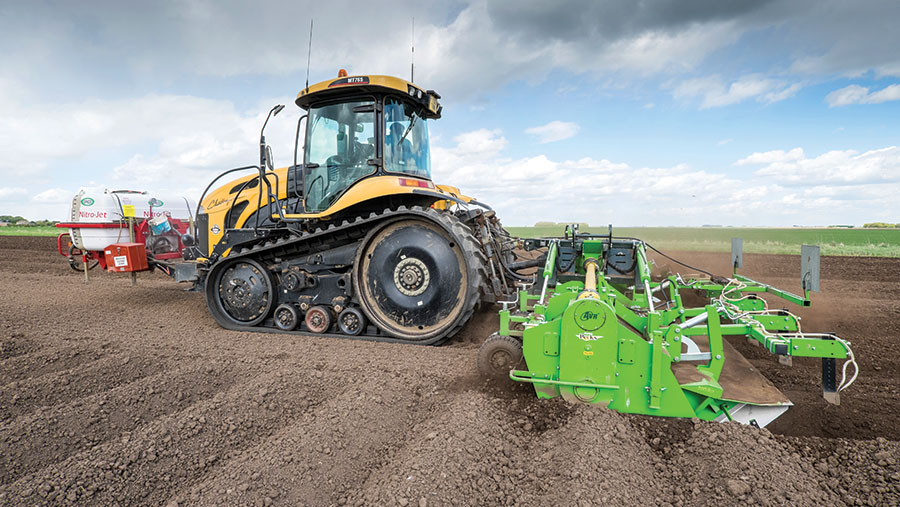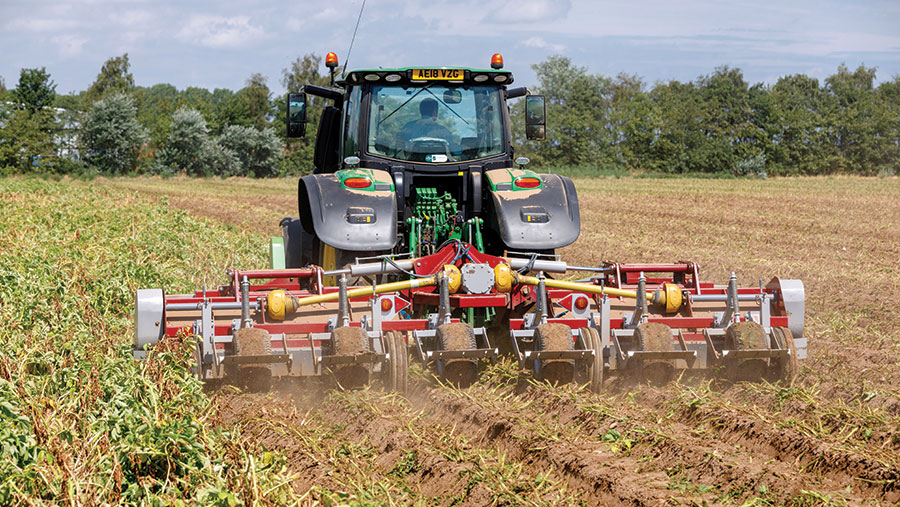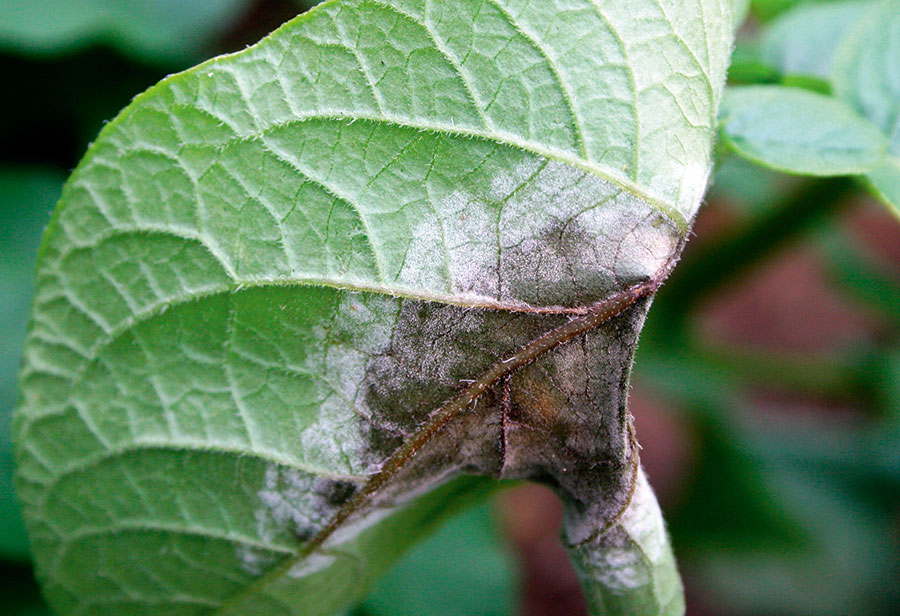How to plan potato planting for trouble-free crop desiccation
 © Tim Scrivener
© Tim Scrivener With the absence of desiccant diquat, potato producers are being advised to pay careful attention to field layout, nitrogen management and blight control strategy before planting this spring.
Most independent experts agree a flail-and-spray approach is the next best means of quickly and reliably killing potato haulm after diquat.
It involves a single pass with a flail topper, quickly followed by a single application or sequence of protoporphyrinogen oxidase (PPO)-inhibitor herbicides such as Spotlight Plus or Gozai to kill stems and any remaining green leaf.
Machinery manufacturers have reported a big increase in topper sales in recent months, suggesting that many growers and contractors are gearing up for this mechanical approach.
See also: Video: Top tips for successful potato flailing
This is a trend independent potato expert John Keer is seeing across Lincolnshire and East Anglia, with most of his clients investing in their own dedicated machine for 2020.
“It gives you the speed of kill to help manage blight, as it can develop on parts of the canopy that don’t get taken out as quickly by chemicals alone.
“Having your own machine also gives you that extra bit of control over which crops get knocked off and when.”
Here, we look at some of the implications of switching from diquat to a flail-and-spray approach and how growers can plan ahead to mitigate any problems that might occur.
Plan field layout
Careful consideration should be given to how fields are laid out at planting to ensure the additional machinery operation can be accommodated without damaging the crop.
Grower and contractor CS Backhouse produces about 80ha of potatoes in Goole for the chip shop trade each year, and last season invested in a Scott’s Trinity 6000 three-bed topper.
Edward Backhouse, who runs the business alongside his brother, David, says they wanted to get one step ahead and try out the machine while diquat was still available. They learned some valuable lessons from this experience.
On 10ha of his own 2019 crop set aside for topping, Mr Backhouse left two 1.83m beds in addition to the sprayer tramline unplanted, creating an internal headland to accommodate the topper.
It was hoped this would provide enough room for the rear topper units to finish rows and the tractor to turn around without running on and damaging crop, but Mr Backhouse was unable to do so.
This is problematic, as green material left at the end of rows increases blight risk and running on beds can cause harvesting problems and damage tubers, making them more susceptible to fungal or bacterial pathogens.
“We were surprised at how big an area you need to turn on, and it could catch a few people out,” says Mr Backhouse.
“You’ll need to consider the length of your setup and the space required to get in and out of beds in a straight line. An extra three beds seem to be the minimum for us after last year.”
In addition, when carrying out some contract work, Mr Backhouse found that if beds were not consistently spaced, the topper was unable to work effectively.

© Gary Naylor
On his own land, using RTK guidance when forming beds has improved uniformity of beds and suggests those planning on flailing should consider adopting it or using a contractor with the technology.
In addition to bed uniformity, Stuart Wale, potato expert at SAC Consulting, says flail users in Scotland have tweaked planter setup to ensure wheelings made during flailing operation aren’t causing compaction in the ridge.
The two rows within a potato bed are traditionally on 90cm spacings, but these can be set slightly narrower to give tyres room and reduce associated problems at harvest.
“Tyre sizes and pressures also need to be looked at, as you will be travelling up every third bed and it can make a mess.”
Pre-planting checklist
- Plan field layout to allow space for flailing machine without running over rows
- Manage nitrogen carefully to avoid overlush canopies
- Stay on top of late-season disease, as the longer desiccation process increases tuber blight risk
Manage nitrogen carefully
One aspect of crop management that can have a significant effect on speed and effectiveness of haulm destruction is nitrogen management.
Some have suggested nitrogen should be cut back to help avoid overvigorous canopies and bring crops to a state of natural senescence ahead of flailing or spraying.
However, after recent and significant excess winter rainfall, Dr Keer believes it is not the season to be reducing nitrogen rates and potentially compromising yield.
It is also important not to generalise, and growers should sample and analyse fields destined for potatoes, if they haven’t already done so, to accurately gauge how much mineral nitrogen is left in the top 60cm of the profile.
Alternatively, growers can work through the RB209 tables and account for factors such as winter rainfall in order to get appropriate nitrogen rates for this year.
In addition to lower soil mineral N, Dr Keer says the wet winter means soil conditions are likely to be suboptimal, particularly on medium and heavy soils.
With poorly structured or cloddy ridges, plant roots won’t be able to scavenge for nutrients as effectively, so cutting fertiliser rates – particularly nitrogen – is not advised.
“The economics of growing potatoes are such that you have to go for maximum potential yield and accept that desiccation of a vibrant haulm is a secondary problem.
“I would err on the side of caution and provide slightly more, rather than less, nutrition – particularly where tilth in the ridge is poor,” says Dr Keer.
Dr Wale says the Scottish area has not been as severely affected by wet weather as England, and for the majority of growers, he advises sticking to standard recommendations.
However, he says those thinking of reducing rates below the norm to ease haulm destruction should beware.
“I certainly think you might compromise yield. Remember that recommendations are based on trials data and established logic, so the advice is don’t go over the top and don’t go under, either.”
Active ingredients
Desiccants/herbicides
Gozai – pyraflufen-ethyl
Spotlight – carfentrazone-ethyl
Fungicides
Infinito – fluopicolide + propamocarb
Ranman Top – cyazofamid
Shinkon – amisulbrom
Shirlan – fluazinam
Zorvec Enicade – oxathiapiprolin
Stay on top of blight
Flailing and spraying will still take slightly longer to completely kill all green leaf and stem than diquat sequences, while PPO inhibitors alone will take considerably longer, increasing tuber blight risk at the end of the season.
Dr Keer says at least one more blight spray will be needed at the end of the season to prevent zoospores developing on lingering green haulm being washed into ridges.
With Shirlan no longer recommended for tuber blight control due to the presence of insensitive 37_A2 isolates across Britain, growers have just Ranman Top, Shinkon and Infinito that offer zoospore activity.

© Blackthorn Arable
It is advised that enough of these products are held back for the end of the season, allowing growers to prevent tuber blight infection without exceeding any maximum total dose.
It should also be noted that Ranman Top and Shinkon share the same mode of action, so alternating with Infinito after flail/burndown will help to manage any fungicide-resistance risk.
Dr Keer has traditionally favoured the systemic Infinito during periods of rapid growth, but this can now be replaced by new products containing oxathiapiprolin, such as Zorvec Enicade.
Therefore, he’ll be retaining some of Infinito’s maximum total dose for the end of the season and rotating with Ranman Top where necessary.
“Tuber blight information is difficult to obtain, so I tend to rely on products that have long-standing data behind them. Tuber blight is not something you want to take a risk with.”
Dr Wale adds that in no circumstances should crops be flailed where blight is present and, in those situations, a chemical-only approach should be adopted to minimise spread.
With PPOs, kill will be slow and although growers can throw some very effective chemistry at outbreaks to stop blight getting on to tubers, it can be an expensive exercise.
For that reason, Dr Wale says watertight blight programmes from start to finish should be planned to prevent the need for firefighting at the back end.
“Prevention is definitely better that cure, particularly with 36_A2 and 37_A2 strains around. When you get bad blight conditions, tighten those intervals up from seven days to five.
“We did a calculation that showed every pound you spend on controlling blight in the field saves at least 10 times the cost of handling infected tubers in store.”

